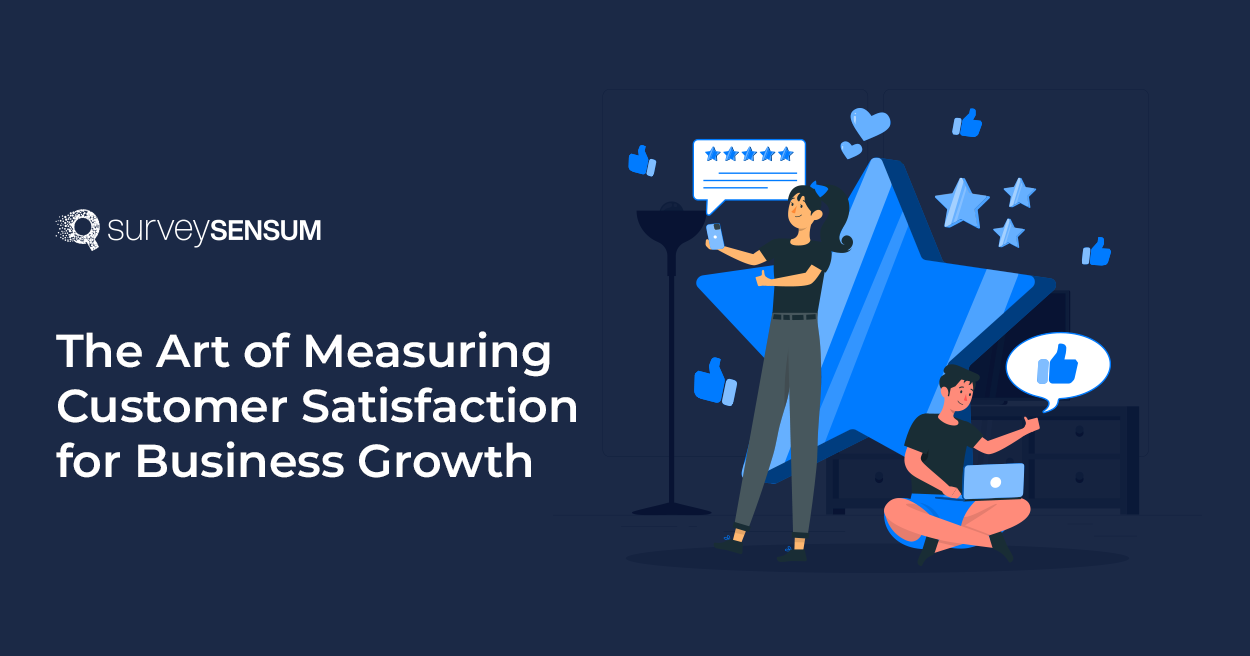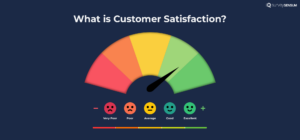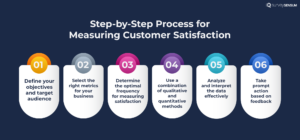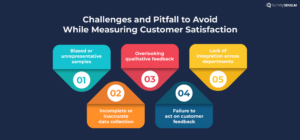5 Ways a Private Marketplace Enhances the Buying Experience
Read More

I recently bought a sunscreen from a new skincare brand. It got delayed so I reached out to customer support. They listened to my issue and got the product delivered within the next 2 hours along with some additional free samples.
Now how will you rate your experience with the brand? Positive, right?
For the brand, this is called achieving customer satisfaction.
But how do you get to know exactly how satisfied your customers are?
This is where the CSAT metric steps in! This metric will help you know exactly how satisfied your customers are with your product or service, or the overall experience and how you can improve the same!
And to know all this, you need robust CSAT software that makes this process feel like a piece of cake!
But what about all the Whats, Whys, and Hows that you need to know about measuring customer satisfaction? – Let’s get to that
First, let’s know why it is important to measure customer satisfaction!

Here are some points to help you understand the importance of measuring customer satisfaction for your business.
Satisfied customers are more likely to stay loyal to a product or service, repurchase it, and make recommendations to others. But why is that an important point for businesses to care about?
According to Saravana Kumar, a former Forbes council member, acquiring a new customer costs 5-7 times more than retaining existing customers.
And how does a business retain customers? Simple, by enhancing the customer experience which is why businesses need to start measuring customer satisfaction and work on their weak areas.
The key to running a successful business is to always look for weaknesses and convert them into opportunities. Demand changes, strategies get old, and competitors get more advanced, which is why it is important to know where you are failing and could fail in the future and improve.
But how to do that?
By regularly monitoring customer satisfaction metrics and paying heed to the changing customer feedback trends, businesses can track progress, set improvement targets, and implement changes to enhance overall customer experiences.
No matter which sector your business operates in, competition is inevitable. Therefore, gaining a competitive advantage over your rivals becomes a crucial goal. But how can you achieve this?
By consistently delivering high levels of customer satisfaction, successful businesses differentiate themselves and stay ahead of the curve in the market.
According to a report on Consumer Intelligence by PwC, 32% of customers would cease doing business with a brand after just one bad experience, highlighting the significance of customer service.
While your competitors are busy acquiring new customers, you already possess a loyal customer base that not just loves your brand but advocates for it.
Measuring customer satisfaction helps identify your best customers cum influencers for your brand, uncover your strengths and more importantly, your weaknesses in comparison to your competitors, empowering businesses to develop strategies that surpass their rivals and attract a larger customer base; in turn, transforming you to have a big-league mentality.
Customer satisfaction plays a crucial role in forming loyal customers who make repeat purchases, which ultimately increase the profitability of a business.
Even a report from Salesforce says that 74% of customers are likely to make a repeat purchase if they are satisfied with the overall experience.
An increase in customer satisfaction has a direct and positive impact on your revenue. And this is something you cannot ignore, both for your business and your customers.
Now that we have understood the meaning and importance of measuring customer satisfaction, it is time we learn the 6 basic steps of measuring customer satisfaction.

Defining objectives, and target audience is a fundamental step for any business. Without clear goals and a properly identified target audience, businesses cannot effectively operate. This principle also applies to measuring customer satisfaction.
Let’s consider a scenario where you ask your team to provide you with the analysis of a survey conducted last week on the prototype of your upcoming mobile app, scheduled to be launched next month.
You want to know how well it was received by people between the ages of 25-35, your key demographic for the app. In this example, you have successfully defined your objective of measuring customer satisfaction and have identified your target audience.
By defining your objectives and target audience, you gain a clear and specific understanding of why you are measuring customer satisfaction.
It aligns your efforts and resources towards gathering relevant feedback and insights to assess the satisfaction of your intended audience, enabling you to make informed decisions and improvements for the successful launch of your mobile app.
Now that you have defined your objectives and target audience properly, it is time to select the right metric for your business. Selecting the right type of metrics depends on your objective.
Common metrics include CSAT Score, Net Promoter Score, and Customer Effort Score. Selecting the right metric that aligns with your goals and is relevant to your industry and customer base is very important.
Let’s say, you want to improve your customer service experience. And want to analyze how well your customers are responding. So, the right metric would be CSAT and not Relationship NPS. Why? Because relationship NPS helps you gauge the overall relationship between the customer and the brand and not the customer experience of an individual transaction.
With CSAT you can ask your customers to directly rate your customer support services and based on those ratings you can calculate the CSAT score and evaluate your customer support.
So, taking the time to define the right metric for your objective is very important.
After defining your objective and selecting the right metric for your objective, it is now important to determine the frequency for measuring satisfaction.
The optimal frequency for customer satisfaction surveys is sending the survey immediately after the customer’s interaction, such as a purchase or support interaction, with your brand. This way the interaction is fresh in the mind of the customer and they can give their honest feedback.
This step is all about finding the right balance between gathering enough relevant data to accurately assess customer satisfaction and avoiding survey fatigue or overwhelming your customers with frequent feedback requests.
Start gathering real-time customer insights with SurveySensum and measure satisfaction immediately after interactions for actionable insights!

Designing your survey is an important part of the customer satisfaction measurement process. By design, we don’t mean picking beautiful formats. It means designing the questions that you want to ask your customers.
This will help you in listing down questions that are important to your objective.
Asking unnecessary questions that won’t help you with your objective is a waste of your time and might also make your customer feel frustrated. So, ask questions that are in line with your objective.
Let’s say you ask your customers for feedback after the customer service calls. Some relevant CSAT survey questions can be:
These questions are relevant, short, and easy to answer. Customers will not feel overwhelmed and will answer all the questions easily. But if you add questions such as:
These types of questions have nothing to do with customer service quality and therefore might frustrate your customers and they might leave the survey halfway.
Also, while designing surveys it is important to add both qualitative and quantitative questions. For example, you ask customers about your newly launched mobile app. You can ask questions such as,
Now, you have quantitative data with close-ended questions but what about if you want to know why a user chose 1 or 5?
This is why you need to add open-ended questions asking users why they gave a 1-star or 5-star rating.
→ Read further to optimize your customer satisfaction survey design!

Now that you have defined your objectives, selected metrics, and designed your surveys, it is now time to analyze and interpret the collected data effectively, by using an effective customer satisfaction tool, so that you can plan further actions.
Once the data has been gathered, analyze it to find trends, patterns, and areas that need attention.
How? — With Text Analytics.
For instance, SurveySensum’s AI-enabled Text Analytics tool analyzes thousands of feedback gathered in just a few minutes and offers you top trends and sentiments. This not only saves hours of effort and time for manual coding but also helps in resolving the issues before they escalate.
Analyze Customer Feedback with Text Analytics – Request a Demo

Surveys are designed, feedback received analyzed, and interpreted, now one last thing left to do, is take action. Because what is the point of doing this exercise if the customer feedback is simply lying around and you are not leveraging it to improve customer satisfaction?
The right customer satisfaction software is of great use here.
For instance, ‘detractor alert’, a SurveySensum feature notifies you as soon as someone gives you negative feedback. With this real-time notification, you can resolve the issue in time or inform the relevant team, so that they can take action.
By taking prompt action on customer feedback, you can close the feedback loop right away and inform the customer about it – leading to the conversion of the detractors to promoters and boosting customer satisfaction.
After knowing all the ways to measure your customer satisfaction, why delay? Launch CSAT surveys to know more about your customers with SurveySensum today!
→ Know more about How to measure customer satisfaction effectively!
So, now we have learned an effective process to measure customer satisfaction but what about the pitfalls?
Well, let’s find out.
Here are some types of customer satisfaction methods commonly used to measure customer satisfaction, along with a brief explanation of each:
These methods can be used individually or in combination to gain a comprehensive understanding of customer satisfaction levels and areas for improvement.
→ Read more about the strategic impact of the journey-based csat survey!
Before incorporating any new customer satisfaction strategy or planning, it is very important to know the challenges that come with it and how to overcome them.
So, here are the five challenges and pitfalls that companies need to be careful of while measuring customer satisfaction.

One of the biggest issues faced during surveys is biased feedback. This happens when customers provide feedback that is influenced by their own preferences or personal experiences which may lead to inaccurate representation of customer experience.
To avoid this,
Error in collecting data or incomplete responses can significantly impact the quality and accuracy of surveys hence making it difficult to get accurate results.
To avoid this error,
As we discussed above, an important step in measuring customer satisfaction is including both quantitative and qualitative questions to get accurate results. While quantitative metrics provide numerical scores, qualitative feedback can provide valuable context and insights.
By solely focusing on the numbers, you might end up losing important information about what’s driving customer satisfaction levels. Qualitative feedback gives you the context and insights that can help you truly understand your customers’ experiences and make meaningful improvements.
So, you’ve gone through the trouble of collecting feedback from various channels and doing a thorough analysis. But here’s the thing, if you don’t actually do anything with that valuable information, then it’s all just a big waste of time, effort, and resources, right?
Measuring customer satisfaction is just the beginning. It’s what you do with those findings that truly matters. If you ignore the feedback and fail to take action, not only will you be wasting all that hard work, but you’ll also risk leaving your customers feeling unsatisfied and disappointed.
To avoid this, it is crucial to put your insights into action. Set up a system for regular review, track your progress, and take the necessary steps to improve based on what your customers are telling you. And don’t forget to let your customers know about the actions you’ve taken. Show them that their feedback is not only appreciated but also used to make positive changes.
In any business, you often find different departments doing their own thing when it comes to collecting customer feedback. This can lead to fragmented information and make it tough to get a clear picture of customer satisfaction throughout their journey with your company.
For example, if your product team is not made aware of the complaints of customers received by the marketing team through omnichannel feedback then they won’t be able to act on those complaints and fix the issue.
This lack of proper communication and disconnect between teams will automatically lead to lower customer satisfaction as the customer’s problems are not solved.
The key to avoiding this issue is good old cross-departmental collaboration. By getting everyone on the same page and establishing proper communication channels, you can ensure that customer feedback is shared and analyzed in a more integrated way.
Transform your feedback into actionable insights with SurveySensum! Don’t let valuable feedback go to waste and act today!
Deep diver into the Customer satisfaction strategy to avoid these pitfalls!
Now the challenge is, what do you exactly do with the score?
Taking action based on customer satisfaction scores is vital for improving customer experience and retention. It’s not just about collecting data but also about understanding the triggers for unhappy customers and proactively addressing issues. Here’s a structured approach to leverage your customer satisfaction data effectively:
By following these customer satisfaction best practices and continually refining your approach based on customer feedback, you can not only improve satisfaction scores but also drive meaningful improvements in customer experience and retention.
In conclusion, measuring customer satisfaction is a vital practice for businesses seeking to understand and meet customer expectations as it offers valuable insights into the overall customer experience, identifies areas for improvement, and helps build long-term customer loyalty.
To achieve all this, you need to look no further than SurveySensum. It is a robust customer feedback platform which provides you with a variety of options like NPS, CSAT, and CES surveys that you can use to gather feedback quickly and efficiently. This will help you in knowing your customers better, and with the help of features like CX consultation and Text Analytics, you will be able to make changes to increase their customer satisfaction and enhance your business performance.
Maximize customer satisfaction and drive business success with SurveySensum!
1. How do you measure customer satisfaction?
Customer satisfaction can be measured through various methods such as surveys, feedback forms, NPS, CSAT, CES, customer reviews and ratings, social media monitoring, and direct customer interactions. These methods gauge customers’ perceptions, experiences, and opinions about products, services, or overall experiences, helping businesses understand and improve customer satisfaction levels.
Customer satisfaction is a qualitative and quantitative measurement. Qualitatively, it involves understanding customers’ feelings, perceptions, and experiences, often gathered through open-ended feedback, comments, and reviews. Quantitatively, it can be measured using numerical scales, ratings, scores, and metrics such as Net Promoter Score or Customer Satisfaction Score. Combining both qualitative and quantitative approaches provides a comprehensive understanding of customer satisfaction levels.
Measuring customer satisfaction is crucial for businesses as it provides valuable insights into customer experiences, preferences, and perceptions. It helps identify areas for improvement, assess the effectiveness of products or services, understand customer needs and expectations, and gauge overall satisfaction levels. By regularly measuring customer satisfaction, businesses can make data-driven decisions, enhance customer retention, build loyalty, improve brand reputation, and ultimately drive long-term success and growth.
Key Performance Indicators for measuring customer satisfaction include metrics like NPS, CSAT, CES, retention rate, churn rate, average response time to customer queries, repeat purchase rate, and customer lifetime value CLV. These KPIs provide quantitative insights into customer sentiments, loyalty, engagement, ease of doing business, and overall satisfaction levels. Analyzing these metrics helps businesses assess performance, identify areas for improvement, and drive strategies to enhance customer satisfaction and loyalty.
Customer satisfaction can be measured using surveys, feedback forms, Net Promoter Score NPS, CES, and through monitoring customer interactions and sentiments on social media and review platforms.
The three main measures of customer satisfaction are surveys CSAT, NPS, and CES which help in analyzing customer behavior and engagement metrics.
Customer satisfaction can be calculated using different metrics. For example, CSAT is calculated by dividing the number of satisfied customers by the total number of survey respondents and multiplying by 100 to get a percentage.
→ Know more about How to Calculate CSAT scores efficiently!
The four key metrics for measuring customer satisfaction are CSAT, NPS, CES, and monitoring customer sentiments and feedback across various channels like social media, reviews, and direct interactions.
Unlock the power of customer insights and kickstart your survey journey with SurveySensum!
